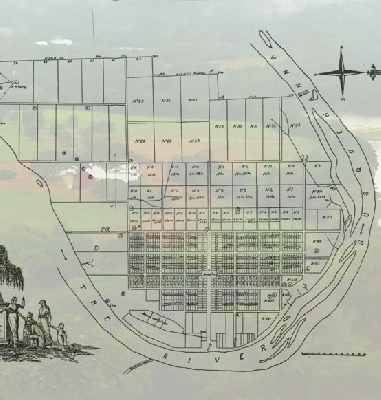French Azilum History

Located on a horseshoe bend in the Susquehanna River near present-day Wysox, Pennsylvania, Azilum provided refuge for a group of French exiles in the autumn of 1793 and spring of 1794.
Some of the refugees, loyal to the King, left France to escape the horrors of the Revolution; others fled the colony of Santo Domingo (Haiti) to escape the slave uprising there. The French refugees, mostly nobility and gentry, even believed that it might be possible for the Queen of France, Marie Antoinette, and her two children to come to Azilum if they got out of France alive. In the plans of the settlement there was a house built for the queen, called La Grand Maison.
Robert Morris, John Nicholson, Stephen Girard and several other financiers and investors who were located chiefly in Philadelphia were sympathetic to the plight of these exiles. Philadelphia at that time had a very large French population, and was a logical destination for those fleeing the guillotine. But the investors also saw an opportunity to profit financially from the influx of immigrants.
They formed a consortium, and purchased sixteen hundred acres of land from the English and German settlers in the area in order to establish Azilum. They also purchased several thousand additional acres over the next few years, extending south into Sullivan County and north nearly to the border of New York State. Three hundred acres were designed as a planned community, with a two-acre market square, a gridiron pattern of broad streets, and 413 residential lots of roughly one-half acre each. Orchards, agricultural plots, grazing land and forest lay beyond the village.
By the following spring, 30 houses of the 50 that would eventually stand, had been built. Although not quite the chateaux the nobles had been used to back in France, these snug houses had chimneys, wallpaper, window glass, shutters and porches. La Grand Maison, the most imposing structure, was the setting of many of the social gatherings for the village, and housed Talleyrand and Louis Phillippe (future King of France) as guests. This was also the house that was to have been the Queen's, had she survived the revolution and escaped.
The duration of the sophisticated French town in the wilderness was brief. Economic factors, including the bankruptcy of Morris and Nicholson, led to the settlement's decline. By the late 1790's many of the French had moved to southern cities or returned to Santo Domingo. In 1803 Napoleon made it possible for the exiles to return to France. A few families, including the LaPortes, remained. These families and their descendants helped to settle nearby communities. None of the almost 100 buildings from Azilum, including houses, a chapel, a theatre and several shops, remain. The town plots were abandoned and absorbed into larger tracts of land that were farmed for most of the 19th and 20th centuries, and sold off to other families in the area. And so, Azilum passed into history.
Today, the historic site contains over twenty acres that were part of the original settlement. Although no structures from the original settlement survive, an original foundation has been left exposed for public viewing . A reconstructed and relocated log cabin, circa 1790, serves as a small museum with artifacts pertaining to the settlement and a video about the establishment of Azilum. Guided tours of the LaPorte house, the summer home of the son of one of the original settlers, are also available. Visitors can see several outbuildings, part of the de Siebert and LaPorte Farms, and outdoor exhibits as part of their self-guided tour of the site.
